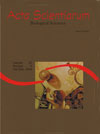<b>Selective feeding of food organisms by fish larvae of <em>Piaractus mesopotamicus</em> (Holmberg, 1887) and <em>Prochilodus lineatus</em> (Valenciennes, 1836)</b> - DOI: 10.4025/actascibiolsci.v29i2.523
Abstract
The objective was to evaluate the feeding selection of food organisms for two species of fish larvae (pacu and curimba) at different ages (6, 12, 19 and 26 days after eclosion), in the presence or absence of Pistia stratiotes. Four treatments were used (T1 = pacu + P. stratiotes; T2 = pacu; T3 = curimba + P. stratiotes; T4 = curimba) and four replications. Every seven days, 24 fish larvae of each species were collected, and kept without food for 24 hours. After being distributed in the aquariums with plankton, the larvae stayed for three hours, and were collected and prepared for analysis, along with the water samples. The digestive tract of the fish larvae were removed and analyzed under an optic microscope. Statistic differences in selective feeding of plankton organisms were reported for larvae of the same species, of different age groups and also among larvae of different species of the same age. There were no observed differences as for the presence or absence of P. stratiotes. The fish larvae of pacu and curimba selected similar organisms at six days old, with changes until the 26th day. As they developed, the pacu larvae began to select cladocerans and ostracods, and the curimba selected protozoans and algae.Downloads
Download data is not yet available.
Published
2007-12-05
How to Cite
Marques, N. R., Hayashi, C., Galdioli, E. M., & Fernandes, C. E. B. (2007). <b>Selective feeding of food organisms by fish larvae of <em>Piaractus mesopotamicus</em> (Holmberg, 1887) and <em>Prochilodus lineatus</em> (Valenciennes, 1836)</b> - DOI: 10.4025/actascibiolsci.v29i2.523. Acta Scientiarum. Biological Sciences, 29(2), 167-176. https://doi.org/10.4025/actascibiolsci.v29i2.523
Issue
Section
Ecology and Limnology
DECLARATION OF ORIGINALITY AND COPYRIGHTS
I Declare that current article is original and has not been submitted for publication, in part or in whole, to any other national or international journal.
The copyrights belong exclusively to the authors. Published content is licensed under Creative Commons Attribution 4.0 (CC BY 4.0) guidelines, which allows sharing (copy and distribution of the material in any medium or format) and adaptation (remix, transform, and build upon the material) for any purpose, even commercially, under the terms of attribution.
Read this link for further information on how to use CC BY 4.0 properly.
0.6
2019CiteScore
31st percentile
Powered by 

0.6
2019CiteScore
31st percentile
Powered by 











1.png)




3.png)













